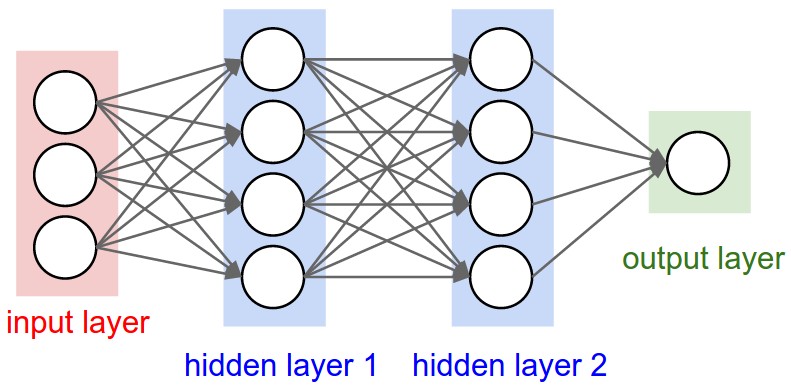In neuroscience, a neural network is a series of interconnected neurons whose activation defines a recognizable linear pathway. The interface through which neurons interact with their neighbors usually consists of several axon terminals connected via synapses to dendrites on other neurons. If the sum of the input signals into one neuron surpasses a certain threshold, the neuron sends an action potential (AP) at the axon hillock and transmits this electrical signal along the axon.
But in terms of AI, neural network refers to Artificial Neural Network.
So, what is Artificial Neural Network
The simplest definition of a neural network, more properly referred to
as an 'artificial' neural network (ANN), is provided by the inventor of
one of the first neurocomputers,
Dr. Robert Hecht-Nielsen. He defines a neural network as:
a computing system made up of a number of simple, highly interconnected processing elements, which process information by their dynamic state response to external inputs.
In Neural Network Primer: Part I by Maureen Caudill, AI Expert, Feb. 1989
An artificial neuron network (ANN) is a computational model based on
the structure and functions of biological neural networks. Information
that flows through the network affects the structure of the ANN because a
neural network changes - or learns, in a sense - based on that input
and output.
ANNs are considered nonlinear statistical data modeling tools where the
complex relationships between inputs and outputs are modeled or
patterns are found.
One of the most important feature of ANN is its ability to learn. It changes it internal structure based on the information flowing through it, i.e., changing its internal weights. A weight is something thats controls information flow between two neurons in a neural network.
Most ANNs contain some form of 'learning rule' which modifies the weights of the connections according to the input patterns that it is presented with. In a sense, ANNs learn by example as do their biological counterparts; a child learns to recognize dogs from examples of dogs.
Although there are many different kinds of learning rules used by neural networks, this demonstration is concerned only with one; the delta rule. The delta rule is often utilized by the most common class of ANNs called backpropagational neural networks (BPNNs). Backpropagation is an abbreviation for the backwards propagation of error.
Basics of Artificial Neural Network
Neural networks are typically organized in layers. Layers are made up of a number of interconnected 'nodes' which contain an 'activation function'. Patterns are presented to the network via the 'input layer', which communicates to one or more 'hidden layers' where the actual processing is done via a system of weighted 'connections'. The hidden layers then link to an 'output layer' where the answer is output as shown in the graphic below.One of the most important feature of ANN is its ability to learn. It changes it internal structure based on the information flowing through it, i.e., changing its internal weights. A weight is something thats controls information flow between two neurons in a neural network.
Most ANNs contain some form of 'learning rule' which modifies the weights of the connections according to the input patterns that it is presented with. In a sense, ANNs learn by example as do their biological counterparts; a child learns to recognize dogs from examples of dogs.
Although there are many different kinds of learning rules used by neural networks, this demonstration is concerned only with one; the delta rule. The delta rule is often utilized by the most common class of ANNs called backpropagational neural networks (BPNNs). Backpropagation is an abbreviation for the backwards propagation of error.
Uses of Artificial Neural Network
- Pattern Recognition — We’ve mentioned
this several times already and it’s probably the most common
application. Examples are facial recognition, optical character
recognition, etc.
- Time Series Prediction — Neural networks can be used to make predictions. Will the stock rise or fall tomorrow? Will it rain or be sunny?
- Signal Processing — Cochlear implants
and hearing aids need to filter out unnecessary noise and amplify the
important sounds. Neural networks can be trained to process an audio
signal and filter it appropriately.
- Control — You may have read about
recent research advances in self-driving cars. Neural networks are
often used to manage steering decisions of physical vehicles (or
simulated ones).
- Anomaly Detection —Because neural
networks are so good at recognizing patterns, they can also be trained
to generate an output when something occurs that doesn’t fit the
pattern. Think of a neural network monitoring your daily routine over a
long period of time. After learning the patterns of your behavior, it
could alert you when something is amiss.


This is a fabulous post I seen because of offer it. It is really what I expected to see trust in future you will continue in sharing such a mind boggling post ai chatbot online
ReplyDelete